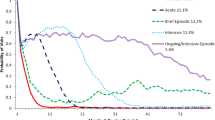Abstract
Service delivery under two systems of care—a traditional Civilian Health and Medical Program of the Uniformed Services (CHAMPUS) reimbursement system and an innovative continuum of care—was examined along six dimensions: access, type, mix, volume, timing, and continuity of services received by children and adolescents. It was found that the Demonstration served over three times as many children as the Comparison. In addition to serving more children, the Demonstration also provided more and different types of services to each child treated. Finally, the Demonstration appears to have delivered services in a more timely fashion and made a considerable effort to match children’s and families’ needs with services.
Similar content being viewed by others
References
Coulam RF, Smith JCH, Thompson JW, et al.:Evaluation of the CPA-Norfolk Demonstration: Final Report. Cambridge, MA: Abt Associates, Inc., 1990.
Taube CA, Rupp A: The effect of Medicaid on access to ambulatory mental health care for the poor and near poor under 65.Medical Care 1986; 24(8):677–686.
Dorken H: CHAMPUS ten-state claim experience for mental disorder: Fiscal year 1975.American Psychologist 1977; 32(9):697–710.
Leaf PJ, Bruce ML: Gender differences in the use of mental health-related services: Are-examination.Journal of Health and Social Behavior 1987; 28:171–183.
Bachrach LL: Is the least restrictive environment always the best? Sociological and semantic implications.Hospital and Community Psychiatry 1980; 31(2):97–103.
Carpenter MD: Residential placement for the chronic psychiatric patient: A review and evaluation of the literature.Schizophrenia Bulletin 1978; 4(3):384–398.
Bickman L, Heflinger C, Pion G et al.: Evaluation planning for an innovative children’s mental health system.Clinical Psychology Review 1992; 12(8):853–865.
Burns BJ: Mental health service use by adolescents in the 1970s and 1980s.Journal of the Academy of Child and Adolescent Psychiatry 1991; 30(1):144–150.
Ranshoff P, Zachary RA, Gaynor J, et al.: Measuring restrictiveness of psychiatric care.Hospital and Community Psychiatry 1982; 33(5):361–366.
Dorken H, VandenBos GR, Cummings N, et al.: Impact of law and regulation on professional practice and use of mental health services: An empirical analysis.Professional Psychology: Research and Practice 1993; 24(3): 256–265.
Rice DP, Kelman S, Miller LS, et al.:The Economic Costs of Alcohol and Drug Abuse and Mental Illness, 1985. Rockville, MD U.S. Department of Health and Human Services, 1990.
Weisz JR, Weiss BH:Effects of Psychotherapy with Children and Adolescents, Newbury Park, CA: Sage, 1993.
Goldman HH, Scheffler RM, Cheadle A: Demand for psychiatric services: A clinical episode model for specifying “the product.”Advances in Health Economics and Health Services Research 1987; 8:255–273.
Haas-Wilson D, Cheadle A, Scheffler R: Demand for mental health services: An episode of treatment approach.Southern Economic Journal 1989; 56(1):219–232.
Kessler LG, Steinwachs DM, Hankin JR: Episodes of psychiatric utilization.Medical Care 1980; 18:1219–1227.
Wells KB, Keeler E, Manning WG: Patterns of outpatient mental health care over time: Some implications for estimates of demand and for benefit design.Health Services Research 1990; 24(6):773–789.
Kazdin A:Conduct Disorders in Childhood and Adolescence. Beverly Hills, CA: Sage, 1986.
Author information
Authors and Affiliations
Additional information
This research is supported by the U.S. Army Health Services Command (DADA 10-89-C-0013) as a subcontract from the North Carolina Department of Human Resources, Division of Mental Health, Developmental Disabilities, and Substance Abuse Services, and a grant to Dr. Leonard Bickman (R01MH-46136-01) from the National Institute of Mental Health. This article is part of a special issue that focuses on the Fort Bragg Evaluation. These articles are best understood when read together. The articles are cross-referenced when it is deemed most appropriate.
Rights and permissions
About this article
Cite this article
Summerfelt, W.T., Foster, E.M. & Saunders, R.C. Mental health services utilization in a children’s mental health managed care demonstration. The Journal of Mental Health Administration 23, 80–91 (1996). https://doi.org/10.1007/BF02518645
Issue Date:
DOI: https://doi.org/10.1007/BF02518645




